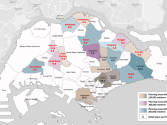Here's why the "through-train" scheme is a win-win
By Nathan Chow Hung Lai (周洪禮)The China Securities Regulatory Commission (CSRC) and the Securities and Futures Commission (SFC), on 10 April, approved in principle, the development of the Shanghai-Hong Kong Stock Connect, a pilot program for establishing mutual stock market access between China and Hong Kong.
An aggregate quota of RMB300 billion and a daily quota of RMB13 billion will be set for the Northbound Trading Link (or investment to China), and RMB 250 billion and RMB 10.5 billion for the Southbound Trading Link (or investment to Hong Kong). These quotas may be expanded in the future.
The Hong Kong Exchange reacted positively to the prospect that the "through-train" scheme, which was originally proposed in 2007, will be back on track soon. Market turnover topped HKD100 billion on the announcement date, well above the average of HKD62 billion over the past 12 months. The share prices of brokers soared. Investors believe the quota will have a significant impact because it accounted for about a quarter of the daily turnover.
In the immediate term, the valuation gap between onshore and offshore listings of the same company is expected to close.
The impact of the pilot scheme is, however, likely to be more far reaching.
Allowing China’s pent-up household wealth to flow offshore
First, the new program is now available to individual investors instead of only institutional investors (i.e, QDII, QFII, and RQFII). This attests to Beijing’s commitment to accelerate the pace of capital account liberalization.
This policy change will have a long-term impact on the assets allocation decisions of Chinese households.
The mainland equity market grew notably in the past two decades. As of January, the combined market capitalization of Shanghai and Shenzhen topped at USD3.9 tn, making it the 5th largest in the world.
Their share of global equity market capitalization tripled to 6.6% (Chart 1) over the past decade.

Despite this, mainland investors are, by international standards, still profoundly underinvested in equities. According to the latest statistics, the financial assets of Chinese households totaled RMB 65 trillion, of which only 12% were allocated in securities, with the bulk (64%) still parked in cash and deposits with negative yields in real terms.
In sharp contrast, US households parked 44% of the their financial assets in securities with only 16% in deposits (Chart 2).

The underinvestment in equities by Chinese households could largely be attributed to irregularities in the mainland markets. Issues such as insider trading and opaque reporting practices eroded retail investors’ confidence.
The pilot scheme allows mainland investors to diversify their investments in the Hong Kong market, which is characterized by a much higher degree of liquidity with operations under effective and transparent regulations.
Under the pilot scheme, mainland investors can trade shares in all the constituents of the Hang Seng Composite LargeCap Index and Hang Seng Composite MidCap Index, and shares of all companies listed on both SSE and SEHK. As such, the new program will improve the efficiency of capital allocation through asset redistribution of Chinese household.
Equally important, the expansion of the cross-border investment channel could enhance competition thereby improve the quality of both markets.
Promoting the offshore use of RMB for investment settlement
On the other hand, in relaxing capital flows between Hong Kong and Shanghai, offshore investors will have an additional avenue to RMB investments. Hitherto, only two offshore RMB-denominated equities have been issued; the Hui Xian REIT (April 2011) and Hopewell Highway Infrastructure (October 2012).
The pilot program allows Hong Kong investors to trade all the constituents of the SSE 180 Index and SSE 380 Index, and shares of all SSE-listed companies which have issued both A shares and H shares. In addition, the SSE offers a wider variety of stock across different industries/sectors for offshore investors.
Presently, H shares are dominated by financial and insurance stocks (92%) whilst the industry weight for non-financial/ insurance stocks in the A share market account for as high as 65% (Chart 3).

More importantly, as RMB-denominated equities become more accessible, the demand for RMB-denominated structured products such as RMB equity-linked note (ELN) and equity-linked deposit (ELD) is expected to surge.
Previously, Hong Kong investors were put off by these products because when these ELN or ELD were exercised, they ended up holding HKD instead of RMB. Instead of reaping the benefits of RMB appreciation, they ended up holding HKD-denominated shares.
By boosting the demand for RMB derivative products, the RMB use for offshore investment settlement purposes can be further promoted. This is an important development to broaden the use of the RMB into the capital account channel.
Daily conversion cap to be removed
While the pilot scheme promotes two-way capital flows, valuation-driven equity flows can, at times, be significantly imbalanced. Given Hong Kong’s limited liquidity pool (~ RMB1,000 bn), its RMB market is vulnerable to liquidity squeeze.
Against this background, it is understandable why the Hong Kong Monetary Authority intends to relax the daily conversion cap for Hong Kong residents (RMB20,000) soon. To avoid impacting the onshore market, the authority also proposed that individuals purchase their CNY offshore instead of approaching the Shanghai conversion window.
One should not be overly concerned that this might stymie the growth of CNH deposit pool. This conversion transaction is only the first-order effect of this impending regulatory change.
The following illustration will provide a better picture of the full impact.
Suppose the demand for investment in the SSE equities is overwhelming, leading offshore investors to demand more CNH to fund their positions. Given the fixed supply of offshore RMB, CNH would rise against the USD, even whilst CNY held constant.
As the CNH widens its premium over the CNY, mainland importers would be incentivized to transfer onshore RMB funds to Hong Kong to settle trades offshore. The larger the CNH-CNY spread, the higher the incentive. More funds will flow into CNH deposits consequently.
On the other hand, the wider CNH-CNY spread would encourage mainland exporters to receive USD from their customers, and subsequently sell the USD for CNY onshore. Such imbalances on CNH settlement lead to a net rise in the offshore RMB liquidity pool (see "CNH: Lifting the offshore conversion cap", 25 October 2013).
Win-win
In summary, the Shanghai-Hong Kong Stock Connect program generates a win-win situation. By enabling mainland investors to directly participate in the Hong Kong stock market using RMB, the development of Hong Kong as an offshore RMB centre can be further promoted. Meanwhile, expanding investment channels for offshore RMB funds can improve the investor profile of the mainland market.
The pilot scheme aims to facilitate cross-border investment flows in which collaborative mechanism may enhance the competitiveness of both markets. That will consolidate the position of Shanghai and Hong Kong as international financial centres.
























 Advertise
Advertise










